Assessment of Land Surface Temperature from the Indian Cities of Ranchi and Dhanbad during COVID-19 Lockdown: Implications on the Urban Climatology
Abstract
:1. Introduction
2. Past Studies
3. Study Area
4. Materials and Methods
4.1. Datasets
4.1.1. Estimation of Top of Atmosphere (TOA) Spectral Radiance
4.1.2. TOA to BT Transformation
4.1.3. Determining the NDVI
4.1.4. Pv Estimation
4.1.5. Land Surface Emissivity (ε) Determination
4.1.6. Land Surface Temperature Estimation
4.1.7. Kriging Interpolation
5. Results and Discussion
6. Conclusions
- The NDVI results from maps depict that vegetation cover is much more in the northeastern regions of Ranch and Dhanbad, which receive abundant rainfall and have lower concrete settlement penetration.
- Study results depicted that vegetative cover is higher in hilly areas in both districts, and with increases in elevation, LST decreased proportionately in the study area.
- Moreover, the LST in the southern & south-eastern parts was low in Dhanbad, while it was evident in the northeastern plateaus of Ranchi.
- The uncultivable lands of (Khilgir and/or Tundi) plains with barren lands in both study areas had higher urban penetration, which experienced comparatively high LST.
- The year of COVID-19, i.e., 2020, reported the lowest temperature in Ranchi & Dhanbad.
- The capital Ranchi remained a minimum of 1 degree Celsius hotter than Dhanbad even in 2020.
- The study also highlights that although both districts in 2019 experienced harsh summer temperatures of more than 40 °C temperature across various regions, it is 2022 which has become the hottest year, with summer temperatures reaching as much as 44.5 °C in the urban centers, depicting the impact of reduced man-incurred activity has faded away and the regions after confronting two consecutive comfortable summers the citizens are now vulnerable to sweltering heat.
- By comparing LST during the lockdown period with the pre-pandemic period, we observed a significant drop in temperature, indicating a meaningful relationship between human activities and urban surface temperature. This analysis provides insights into the impact of reduced human activities during the lockdown on the urban thermal environment and highlights the potential influence of anthropogenic heat on urban temperature.
Author Contributions
Funding
Institutional Review Board Statement
Informed Consent Statement
Data Availability Statement
Conflicts of Interest
Abbreviations
| LST | Land Surface Temperature |
| NDVI | Normalized Difference Vegetation Index |
| UHI | Urban Heat Intensity |
| Km | Kilometers |
| WHO | World health Organization |
| LSE | Land Surface Emissivity |
| UTM | Universal Transverse Mercator |
| UN | United Nations |
| LULC | Land Use Land Cover |
| TOA | Top of Atmosphere |
| USGS | United States Geological Survey |
| OLI | Operational Land Imager |
| BT | brightness temperature |
| NASA | National Aeronautics and Space Administration |
References
- Sajjad, S.H.; Khan, T.; Qadri, S.M.T.; Gilani, N.; Waheed, S. Natural Hazards and Related Contents in Curriculum of Geography in Pakistan. Asian J. Nat. Appl. Sci. 2014, 3, 40–48. [Google Scholar]
- Rahman, Z.; Rehman, K.; Ali, W.; Ali, A.; Burton, P.; Barkat, A.; Ali, A.; Qadri, S.M.T. Re-Appraisal of Earthquake Catalog in the Pamir—Hindu Kush Region, Emphasizing the Early and Modern Instrumental Earthquake Events. J. Seism. 2021, 25, 1461–1481. [Google Scholar] [CrossRef]
- Qadri, S.M.T.; Mirza, M.Q.; Raja, A.; Yaghmaei-Sabegh, S.; Hakimi, M.H.; Ali, S.H.; Khan, M.Y. Application of Probabilistic Seismic Hazard Assessment to Understand the Earthquake Hazard in Attock City, Pakistan: A Step towards Linking Hazards and Sustainability. Sustainability 2023, 15, 1023. [Google Scholar] [CrossRef]
- Talha Qadri, S.M.; Nawaz, B.; Sajjad, S.H.; Sheikh, R.A. Ambient Noise H/V Spectral Ratio in Site Effects Estimation in Fateh Jang Area, Pakistan. Earthq. Sci. 2015, 28, 87–95. [Google Scholar] [CrossRef]
- Qadri, S.M.T.; Sajjad, S.H.; Sheikh, R.A.; Rehman, K.; Rafi, Z.; Nawaz, B.; Haider, W. Ambient Noise Measurements in Rawalpindi—Islamabad, Twin Cities of Pakistan: A Step towards Site Response Analysis to Mitigate Impact of Natural Hazard. Nat. Hazards 2015, 78, 1111–1123. [Google Scholar] [CrossRef]
- Talha Qadri, S.M.; Aminul Islam, M.; Shalaby, M.R.; Khattak, K.R.; Sajjad, S.H. Characterizing Site Response in the Attock Basin, Pakistan, Using Microtremor Measurement Analysis. Arab. J. Geosci. 2017, 10, 267. [Google Scholar] [CrossRef]
- Qadri, S.M.T.; Malik, O.A. Establishing Site Response-Based Micro-Zonation by Applying Machine Learning Techniques on Ambient Noise Data: A Case Study from Northern Potwar Region, Pakistan. Environ. Earth Sci. 2021, 80, 53. [Google Scholar] [CrossRef]
- Talha Qadri, S.M.; Shah, A.A.; Sahari, S.; Raja, A.; Yaghmaei-Sabegh, S.; Khan, M.Y. Tectonic Geomorphology-Based Modeling Reveals Dominance of Transpression in Taxila and the Contiguous Region in Pakistan: Implications for Seismic Hazards. Model. Earth Syst. Environ. 2023, 9, 1029–1050. [Google Scholar] [CrossRef]
- Shah, A.A.; Qadri, T.; Khwaja, S. Living with Earthquake Hazards in South and South East Asia. ASEAN J. Community Engag. 2018, 2, 15. [Google Scholar] [CrossRef]
- Khan, M.Y.; Turab, S.A.; Ali, L.; Shah, M.T.; Qadri, S.M.T.; Latif, K.; Kanli, A.I.; Akhter, M.G. The Dynamic Response of Coseismic Liquefaction-Induced Ruptures Associated with the 2019 Mw 5.8 Mirpur, Pakistan, Earthquake Using HVSR Measurements. Lead. Edge 2021, 40, 590–600. [Google Scholar] [CrossRef]
- United Nations. 68% of the World Population Projected to Live in Urban Areas by 2050, Says UN, UN DESA, United Nations Department of Economic and Social Affairs. Available online: https://www.un.org/development/desa/en/news/population/2018-revision-of-world-urbanization-prospects.html (accessed on 1 July 2023).
- Mallik, R.; Dikkila Bhutia, K.; Roy, S.; Nandi, M.; Dash, P.; Mukherjee, K. Spatio-Temporal Analysis of Environmental Criticality: Planned Versus Unplanned Urbanization. IOP Conf. Ser. Earth Environ. Sci. 2023, 1164, 012014. [Google Scholar] [CrossRef]
- Jardas, M.; Perić Hadžić, A.; Tijan, E. Defining and Measuring the Relevance of Criteria for the Evaluation of the Inflow of Goods in City Centers. Logistics 2021, 5, 44. [Google Scholar] [CrossRef]
- Sahana, M.; Dutta, S.; Sajjad, H. Assessing Land Transformation and Its Relation with Land Surface Temperature in Mumbai City, India Using Geospatial Techniques. Int. J. Urban Sci. 2019, 23, 205–225. [Google Scholar] [CrossRef]
- Tiwari, A.; Suresh, M.; Jain, K.; Shoab, M.; Dixit, A.; Pandey, A. Urban landscape dynamics for quantifying the changing pattern of urbanisation in delhi. J. Rural Dev. 2018, 37, 399. [Google Scholar] [CrossRef]
- Kammen, D.M.; Sunter, D.A. City-Integrated Renewable Energy for Urban Sustainability. Science 2016, 352, 922–928. [Google Scholar] [CrossRef] [PubMed]
- Agergaard, J.; Tacoli, C.; Steel, G.; Ørtenblad, S.B. Revisiting Rural–Urban Transformations and Small Town Development in Sub-Saharan Africa. Eur. J. Dev. Res. 2019, 31, 2–11. [Google Scholar] [CrossRef]
- Kanos, D.; Heitzig, C. Figures of the Week: Africa’s Urbanization Dynamics. Available online: https://www.brookings.edu/articles/figures-of-the-week-africas-urbanization-dynamics/ (accessed on 1 July 2023).
- Seto, K.C.; Fragkias, M.; Güneralp, B.; Reilly, M.K. A Meta-Analysis of Global Urban Land Expansion. PLoS ONE 2011, 6, e23777. [Google Scholar] [CrossRef]
- Shi, K.; Cui, Y.; Liu, S.; Wu, Y. Global Urban Land Expansion Tends To Be Slope Climbing: A Remotely Sensed Nighttime Light Approach. Earths Future 2023, 11, e2022EF003384. [Google Scholar] [CrossRef]
- Alam, T.; Banerjee, A. Deciphering Urbanization and Spatial Disparity in South 24 Parganas District of West Bengal, India. In Proceedings of the 58th ISOCARP World Planning Congress; ISOCARP, Brussels, Belgium, 3–6 October 2022. [Google Scholar]
- Ketterer, C.; Matzarakis, A. Comparison of Different Methods for the Assessment of the Urban Heat Island in Stuttgart, Germany. Int. J. Biometeorol. 2015, 59, 1299–1309. [Google Scholar] [CrossRef]
- Shahfahad; Kumari, B.; Tayyab, M.; Ahmed, I.A.; Baig, M.R.I.; Khan, M.F.; Rahman, A. Longitudinal Study of Land Surface Temperature (LST) Using Mono- and Split-Window Algorithms and Its Relationship with NDVI and NDBI over Selected Metro Cities of India. Arab. J. Geosci. 2020, 13, 1040. [Google Scholar] [CrossRef]
- Parlow, E. Regarding Some Pitfalls in Urban Heat Island Studies Using Remote Sensing Technology. Remote Sens. 2021, 13, 3598. [Google Scholar] [CrossRef]
- Shafiq, M.U.; Rasool, R.; Ahmed, P.; Dimri, A.P. Temperature and Precipitation Trends in Kashmir Valley, North Western Himalayas. Theor. Appl. Clim. 2019, 135, 293–304. [Google Scholar] [CrossRef]
- Gupta, N.; Mathew, A.; Khandelwal, S. Spatio-Temporal Impact Assessment of Land Use / Land Cover (LU-LC) Change on Land Surface Temperatures over Jaipur City in India. Int. J. Urban Sustain. Dev. 2020, 12, 283–299. [Google Scholar] [CrossRef]
- Stewart, I.D.; Oke, T.R. Local Climate Zones for Urban Temperature Studies. Bull. Am. Meteorol. Soc. 2012, 93, 1879–1900. [Google Scholar] [CrossRef]
- Jallu, S.B.; Shaik, R.U.; Srivastav, R.; Pignatta, G. Assessing the Effect of COVID-19 Lockdown on Surface Urban Heat Island for Different Land Use /Cover Types Using Remote Sensing. Energy Nexus 2022, 5, 100056. [Google Scholar] [CrossRef]
- Guha, S.; Govil, S.; Diwan, P. Analytical Study of Seasonal Variability in Land Surface Temperature with Normalized Difference Vegetation Index, Normalized Difference Water Index, Normalized Difference Built-up Index, and Normalized Multiband Drought Index. J. Appl. Remote Sens. 2019, 13, 1. [Google Scholar] [CrossRef]
- Pathak, C.; Chandra, S.; Maurya, G.; Rathore, A.; Sarif, M.O.; Gupta, R.D. The Effects of Land Indices on Thermal State in Surface Urban Heat Island Formation: A Case Study on Agra City in India Using Remote Sensing Data (1992–2019). Earth Syst. Environ. 2021, 5, 135–154. [Google Scholar] [CrossRef]
- Degirmenci, K.; Desouza, K.C.; Fieuw, W.; Watson, R.T.; Yigitcanlar, T. Understanding Policy and Technology Responses in Mitigating Urban Heat Islands: A Literature Review and Directions for Future Research. Sustain. Cities Soc. 2021, 70, 102873. [Google Scholar] [CrossRef]
- Hao, X.; Li, W.; Deng, H. The Oasis Effect and Summer Temperature Rise in Arid Regions—Case Study in Tarim Basin. Sci. Rep. 2016, 6, 35418. [Google Scholar] [CrossRef] [PubMed]
- Fadhil, M.; Hamoodi, M.N.; Ziboon, A.R.T. Mitigating Urban Heat Island Effects in Urban Environments: Strategies and Tools. IOP Conf. Ser. Earth Environ. Sci. 2023, 1129, 012025. [Google Scholar] [CrossRef]
- Vuckovic, M.; Schmidt, J.; Ortner, T.; Cornel, D. Combining 2D and 3D Visualization with Visual Analytics in the Environmental Domain. Information 2021, 13, 7. [Google Scholar] [CrossRef]
- Arifwidodo, S.D.; Tanaka, T. The Characteristics of Urban Heat Island in Bangkok, Thailand. Procedia Soc. Behav. Sci. 2015, 195, 423–428. [Google Scholar] [CrossRef]
- Probst, N.; Bach, P.M.; Cook, L.M.; Maurer, M.; Leitão, J.P. Blue Green Systems for Urban Heat Mitigation: Mechanisms, Effectiveness and Research Directions. Blue Green Syst. 2022, 4, 348–376. [Google Scholar] [CrossRef]
- Hidalgo García, D.; Arco Díaz, J. Impacts of the COVID-19 Confinement on Air Quality, the Land Surface Temperature and the Urban Heat Island in Eight Cities of Andalusia (Spain). Remote Sens. Appl. Soc. Environ. 2022, 25, 100667. [Google Scholar] [CrossRef] [PubMed]
- Oke, T.R. Boundary Layer Climates; Routledge: Abingdon, UK, 2002; ISBN 0-203-40721-0. [Google Scholar]
- Fatemi, M.; Narangifard, M. Monitoring LULC Changes and Its Impact on the LST and NDVI in District 1 of Shiraz City. Arab. J. Geosci. 2019, 12, 127. [Google Scholar] [CrossRef]
- Rajeshwari, A. Estimation of land surface temperature of dindigul district using LANDSAT 8 data. Int. J. Res. Eng. Technol. 2014, 3, 122–126. [Google Scholar] [CrossRef]
- Mathew, A.; Sarwesh, P.; Khandelwal, S. Investigating the Contrast Diurnal Relationship of Land Surface Temperatures with Various Surface Parameters Represent Vegetation, Soil, Water, and Urbanization over Ahmedabad City in India. Energy Nexus 2022, 5, 100044. [Google Scholar] [CrossRef]
- Valjarević, A.; Djekić, T.; Stevanović, V.; Ivanović, R.; Jandziković, B. GIS Numerical and Remote Sensing Analyses of Forest Changes in the Toplica Region for the Period of 1953–2013. Appl. Geogr. 2018, 92, 131–139. [Google Scholar] [CrossRef]
- Tewari, A.; Srivastava, N. Impact of COVID Lockdowns on Spatio-Temporal Variability in Land Surface Temperature and Vegetation Index. Environ, Monit. Assess. 2023, 195, 507. [Google Scholar] [CrossRef]
- Chakraborty, T.; Sarangi, C.; Lee, X. Reduction in Human Activity Can Enhance the Urban Heat Island: Insights from the COVID-19 Lockdown. Environ. Res. Lett. 2021, 16, 054060. [Google Scholar] [CrossRef]
- Imhoff, M.L.; Zhang, P.; Wolfe, R.E.; Bounoua, L. Remote Sensing of the Urban Heat Island Effect across Biomes in the Continental USA. Remote Sens. Environ. 2010, 114, 504–513. [Google Scholar] [CrossRef]
- Teufel, B.; Sushama, L.; Poitras, V.; Dukhan, T.; Bélair, S.; Miranda-Moreno, L.; Sun, L.; Sasmito, A.P.; Bitsuamlak, G. Impact of COVID-19-Related Traffic Slowdown on Urban Heat Characteristics. Atmosphere 2021, 12, 243. [Google Scholar] [CrossRef]
- Akbari, H.; Konopacki, S. Calculating Energy-Saving Potentials of Heat-Island Reduction Strategies. Energy Policy 2005, 33, 721–756. [Google Scholar] [CrossRef]
- Chetia, S.; Saikia, A.; Basumatary, M.; Sahariah, D. When the Heat Is on: Urbanization and Land Surface Temperature in Guwahati, India. Acta Geophys. 2020, 68, 891–901. [Google Scholar] [CrossRef]
- Roshan, G.; Sarli, R.; Grab, S.W. The Case of Tehran’s Urban Heat Island, Iran: Impacts of Urban ’Lockdown’ Associated with the COVID-19 Pandemic. Sustain. Cities Soc. 2021, 75, 103263. [Google Scholar] [CrossRef]
- Arbuthnott, K.G.; Hajat, S. The Health Effects of Hotter Summers and Heat Waves in the Population of the United Kingdom: A Review of the Evidence. Environ. Health 2017, 16, 119. [Google Scholar] [CrossRef]
- Dwivedi, A.; Mohan, B.K. Impact of Green Roof on Micro Climate to Reduce Urban Heat Island. Remote Sens. Appl. Soc. Environ. 2018, 10, 56–69. [Google Scholar] [CrossRef]
- Macintyre, H.L.; Heaviside, C.; Taylor, J.; Picetti, R.; Symonds, P.; Cai, X.-M.; Vardoulakis, S. Assessing Urban Population Vulnerability and Environmental Risks across an Urban Area during Heatwaves—Implications for Health Protection. Sci. Total Environ. 2018, 610–611, 678–690. [Google Scholar] [CrossRef]
- Yang, C.; Yan, F.; Zhang, S. Comparison of Land Surface and Air Temperatures for Quantifying Summer and Winter Urban Heat Island in a Snow Climate City. J. Environ. Manag. 2020, 265, 110563. [Google Scholar] [CrossRef]
- Feizizadeh, B.; Blaschke, T. Examining Urban Heat Island Relations to Land Use and Air Pollution: Multiple Endmember Spectral Mixture Analysis for Thermal Remote Sensing. IEEE J. Sel. Top. Appl. Earth Obs. Remote Sens. 2013, 6, 1749–1756. [Google Scholar] [CrossRef]
- Santamouris, M. Recent Progress on Urban Overheating and Heat Island Research. Integrated Assessment of the Energy, Environmental, Vulnerability and Health Impact. Synergies with the Global Climate Change. Energy Build. 2020, 207, 109482. [Google Scholar] [CrossRef]
- Ghosh, P.; Baladandayuthapani, V.; Banerjee, M.; Mukherjee, B.; Ray, D. Predictions, Role of Interventions and Effects of a Historic National Lockdown in India’s Response to the the COVID-19 Pandemic: Data Science Call to Arms. Harv. Data Sci. Rev. 2020. [Google Scholar] [CrossRef] [PubMed]
- Hua, L.; Zhang, X.; Nie, Q.; Sun, F.; Tang, L. The Impacts of the Expansion of Urban Impervious Surfaces on Urban Heat Islands in a Coastal City in China. Sustainability 2020, 12, 475. [Google Scholar] [CrossRef]
- Huang, X.; Ding, A.; Gao, J.; Zheng, B.; Zhou, D.; Qi, X.; Tang, R.; Wang, J.; Ren, C.; Nie, W.; et al. Enhanced Secondary Pollution Offset Reduction of Primary Emissions during COVID-19 Lockdown in China. Natl. Sci. Rev. 2021, 8, nwaa137. [Google Scholar] [CrossRef]
- Arrofiqoh, E.N.; Setyaningrum, D.A. The Impact of COVID-19 Pandemic on Land Surface Temperature in Yogyakarta Urban Agglomeration. J. Appl. Geospat. Inf. 2021, 5, 480–485. [Google Scholar] [CrossRef]
- El Kenawy, A.M.; Lopez-Moreno, J.I.; McCabe, M.F.; Domínguez-Castro, F.; Peña-Angulo, D.; Gaber, I.M.; Alqasemi, A.S.; Al Kindi, K.M.; Al-Awadhi, T.; Hereher, M.E.; et al. The Impact of COVID-19 Lockdowns on Surface Urban Heat Island Changes and Air-Quality Improvements across 21 Major Cities in the Middle East. Environ. Pollut. 2021, 288, 117802. [Google Scholar] [CrossRef]
- Ali, G.; Abbas, S.; Qamer, F.M.; Wong, M.S.; Rasul, G.; Irteza, S.M.; Shahzad, N. Environmental Impacts of Shifts in Energy, Emissions, and Urban Heat Island during the COVID-19 Lockdown across Pakistan. J. Clean. Prod. 2021, 291, 125806. [Google Scholar] [CrossRef] [PubMed]
- Alqasemi, A.S.; Hereher, M.E.; Kaplan, G.; Al-Quraishi, A.M.F.; Saibi, H. Impact of COVID-19 Lockdown upon the Air Quality and Surface Urban Heat Island Intensity over the United Arab Emirates. Sci. Total Environ. 2021, 767, 144330. [Google Scholar] [CrossRef]
- Di Sabatino, S.; Barbano, F.; Brattich, E.; Pulvirenti, B. The Multiple-Scale Nature of Urban Heat Island and Its Footprint on Air Quality in Real Urban Environment. Atmosphere 2020, 11, 1186. [Google Scholar] [CrossRef]
- Schaefer, M.; Ebrahimi Salari, H.; Köckler, H.; Thinh, N.X. Assessing Local Heat Stress and Air Quality with the Use of Remote Sensing and Pedestrian Perception in Urban Microclimate Simulations. Sci. Total Environ. 2021, 794, 148709. [Google Scholar] [CrossRef]
- Avdan, U.; Jovanovska, G. Algorithm for Automated Mapping of Land Surface Temperature Using LANDSAT 8 Satellite Data. J. Sens. 2016, 2016, 1480307. [Google Scholar] [CrossRef]
- Srivastava, A.K.; Bhoyar, P.D.; Kanawade, V.P.; Devara, P.C.S.; Thomas, A.; Soni, V.K. Improved Air Quality during COVID-19 at an Urban Megacity over the Indo-Gangetic Basin: From Stringent to Relaxed Lockdown Phases. Urban Clim. 2021, 36, 100791. [Google Scholar] [CrossRef]
- Zambrano-Monserrate, M.A.; Ruano, M.A.; Sanchez-Alcalde, L. Indirect Effects of COVID-19 on the Environment. Sci. Total Environ. 2020, 728, 138813. [Google Scholar] [CrossRef] [PubMed]
- Das, N.; Sutradhar, S.; Ghosh, R.; Mondal, P. Asymmetric Nexus between Air Quality Index and Nationwide Lockdown for COVID-19 Pandemic in a Part of Kolkata Metropolitan, India. Urban Clim. 2021, 36, 100789. [Google Scholar] [CrossRef]
- Nakajima, K.; Takane, Y.; Kikegawa, Y.; Furuta, Y.; Takamatsu, H. Human Behaviour Change and Its Impact on Urban Climate: Restrictions with the G20 Osaka Summit and COVID-19 Outbreak. Urban Clim. 2021, 35, 100728. [Google Scholar] [CrossRef]
- Ban-Weiss, G.A.; Woods, J.; Millstein, D.; Levinson, R. Using Remote Sensing to Quantify Albedo of Roofs in Seven California Cities, Part 2: Results and Application to Climate Modeling. Sol. Energy 2015, 115, 791–805. [Google Scholar] [CrossRef]
- Potter, C.; Alexander, O. Impacts of the San Francisco Bay Area Shelter-in-Place during the COVID-19 Pandemic on Urban Heat Fluxes. Urban Clim. 2021, 37, 100828. [Google Scholar] [CrossRef]
- Mandal, I.; Pal, S. COVID-19 Pandemic Persuaded Lockdown Effects on Environment over Stone Quarrying and Crushing Areas. Sci. Total Environ. 2020, 732, 139281. [Google Scholar] [CrossRef]
- Fujibe, F. Temperature Anomaly in the Tokyo Metropolitan Area during the COVID-19 (Coronavirus) Self-Restraint Period. SOLA 2020, 16, 175–179. [Google Scholar] [CrossRef]
- He, G.; Pan, Y.; Tanaka, T. The Short-Term Impacts of COVID-19 Lockdown on Urban Air Pollution in China. Nat. Sustain. 2020, 3, 1005–1011. [Google Scholar] [CrossRef]
- Maithani, S.; Nautiyal, G.; Sharma, A. Investigating the Effect of Lockdown During COVID-19 on Land Surface Temperature: Study of Dehradun City, India. J. Indian Soc. Remote Sens. 2020, 48, 1297–1311. [Google Scholar] [CrossRef]
- Ali, S.S.; Kaur, R.; Gupta, H.; Ahmad, Z.; Elnaggar, G. Determinants of an Organization’s Readiness for Drone Technologies Adoption. IEEE Trans. Eng. Manag. 2021, 1–15. [Google Scholar] [CrossRef]
- Kumar, A.; Pandey, A.C.; Hoda, N.; Jeyaseelan, A.T. Evaluation of Urban Sprawl Pattern in the Tribal-Dominated Cities of Jharkhand State, India. Int. J. Remote Sens. 2011, 32, 7651–7675. [Google Scholar] [CrossRef]
- Mohanta, K.; Sharma, L.K. Assessing the Impacts of Urbanization on the Thermal Environment of Ranchi City (India) Using Geospatial Technology. Remote Sens. Appl. Soc. Environ. 2017, 8, 54–63. [Google Scholar] [CrossRef]
- Kumar, A.; Samadder, S.R. An Empirical Model for Prediction of Household Solid Waste Generation Rate—A Case Study of Dhanbad, India. Waste Manag. 2017, 68, 3–15. [Google Scholar] [CrossRef]
- Population Census 2011 India. Available online: https://www.census2011.co.in/ (accessed on 11 September 2022).
- Ranchi Tehsil Map. Available online: https://www.mapsofindia.com/maps/jharkhand/tehsil/ranchi.html (accessed on 17 December 2022).
- Yasir, M.; Hui, S.; Rahman, S.U.; Ilyas, M.; Zafar, A.; Mehmood, A. Estimation of Land Surface Temperature Using LANDSAT-8 Data—A Case Study of District Malakand, Khyber Pakhtunkhwa, Pakistan. J. Lib. Arts Humanit. 2020, 1, 10. [Google Scholar]
- Chavez, P.S. An Improved Dark-Object Subtraction Technique for Atmospheric Scattering Correction of Multispectral Data. Remote Sens. Environ. 1988, 24, 459–479. [Google Scholar] [CrossRef]
- Mohanasundaram, S.; Baghel, T.; Thakur, V.; Udmale, P.; Shrestha, S. Reconstructing NDVI and Land Surface Temperature for Cloud Cover Pixels of Landsat-8 Images for Assessing Vegetation Health Index in the Northeast Region of Thailand. Environ. Monit. Assess. 2023, 195, 211. [Google Scholar] [CrossRef]
- Cook, M.; Schott, J.; Mandel, J.; Raqueno, N. Development of an Operational Calibration Methodology for the Landsat Thermal Data Archive and Initial Testing of the Atmospheric Compensation Component of a Land Surface Temperature (LST) Product from the Archive. Remote Sens. 2014, 6, 11244–11266. [Google Scholar] [CrossRef]
- Rosado, R.M.G.; Guzmán, E.M.A.; Lopez, C.J.E.; Molina, W.M.; García, H.L.C.; Yedra, E.L. Mapping the LST (Land Surface Temperature) with Satellite Information and Software ArcGis. IOP Conf. Ser. Mater. Sci. Eng. 2020, 811, 012045. [Google Scholar] [CrossRef]
- Kumar, R.; Kumar, A. Estimation of Land Surface Temperature Using LANDSAT 8 Satellite Data of Panchkula District, Haryana. J. Geogr. Environ. Earth Sci. Int. 2020, 24, 47–66. [Google Scholar] [CrossRef]
- Bae, J.; Ryu, Y. Land Use and Land Cover Changes Explain Spatial and Temporal Variations of the Soil Organic Carbon Stocks in a Constructed Urban Park. Landsc. Urban Plan. 2015, 136, 57–67. [Google Scholar] [CrossRef]
- Bashir, M.F.; Ma, B.; Bilal; Komal, B.; Bashir, M.A.; Tan, D.; Bashir, M. Correlation between Climate Indicators and COVID-19 Pandemic in New York, USA. Sci. Total Environ. 2020, 728, 138835. [Google Scholar] [CrossRef] [PubMed]
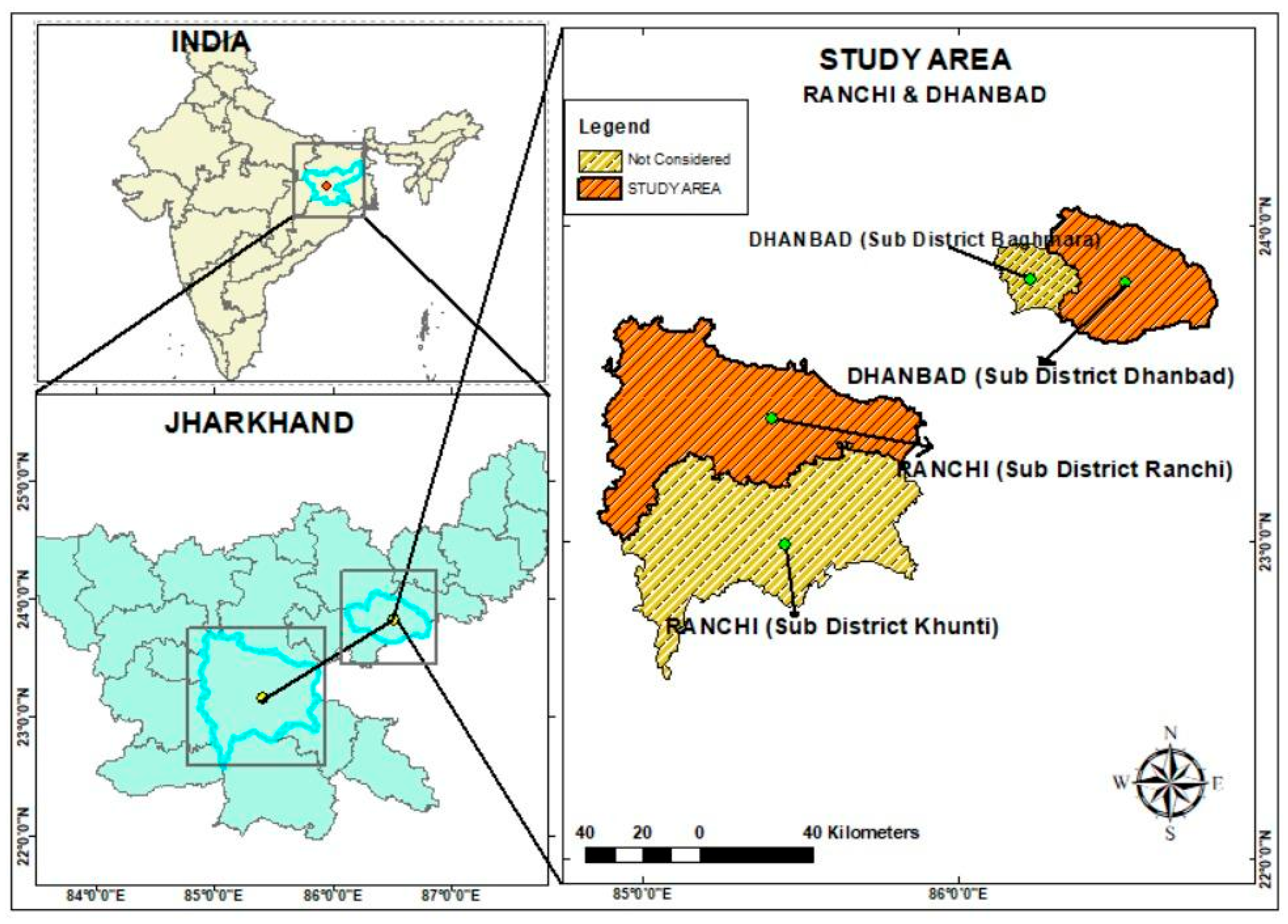







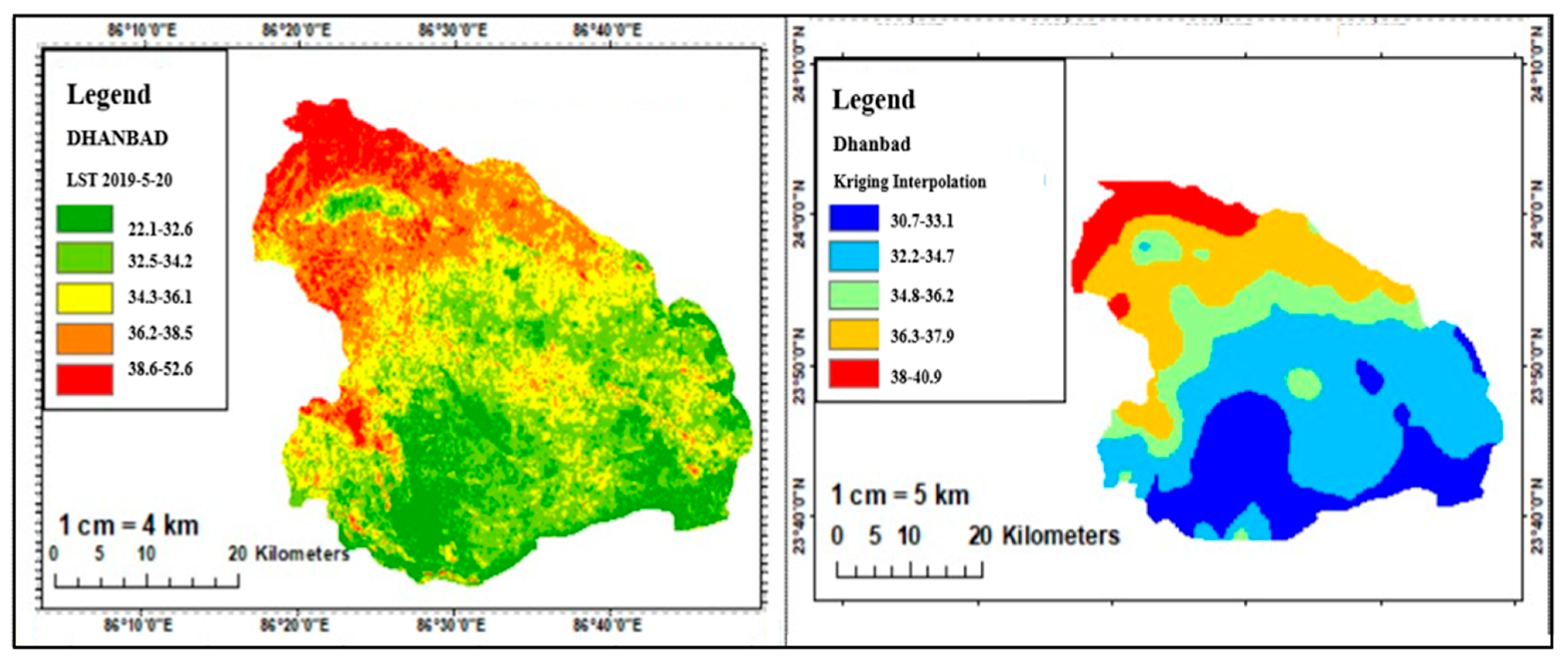

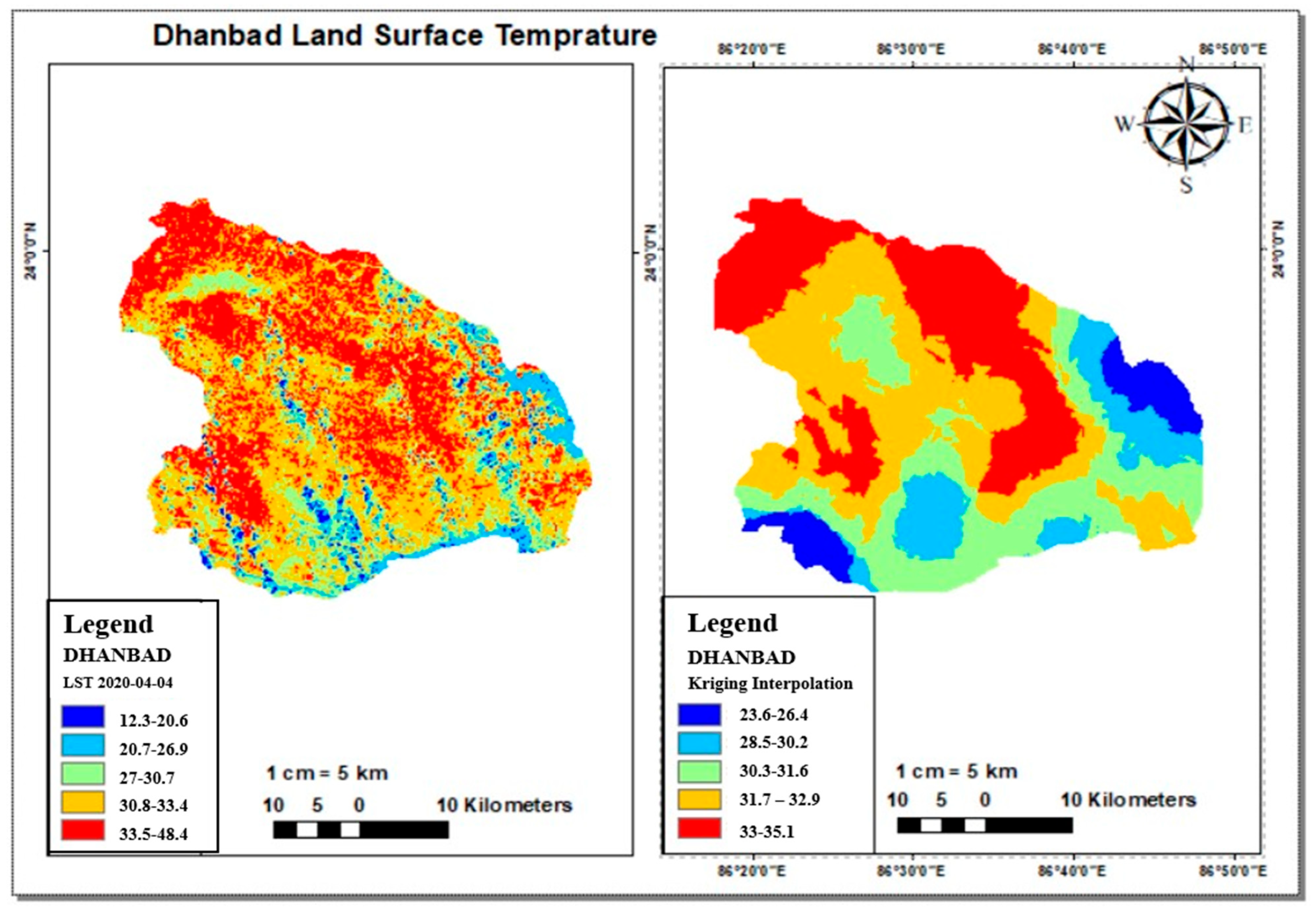
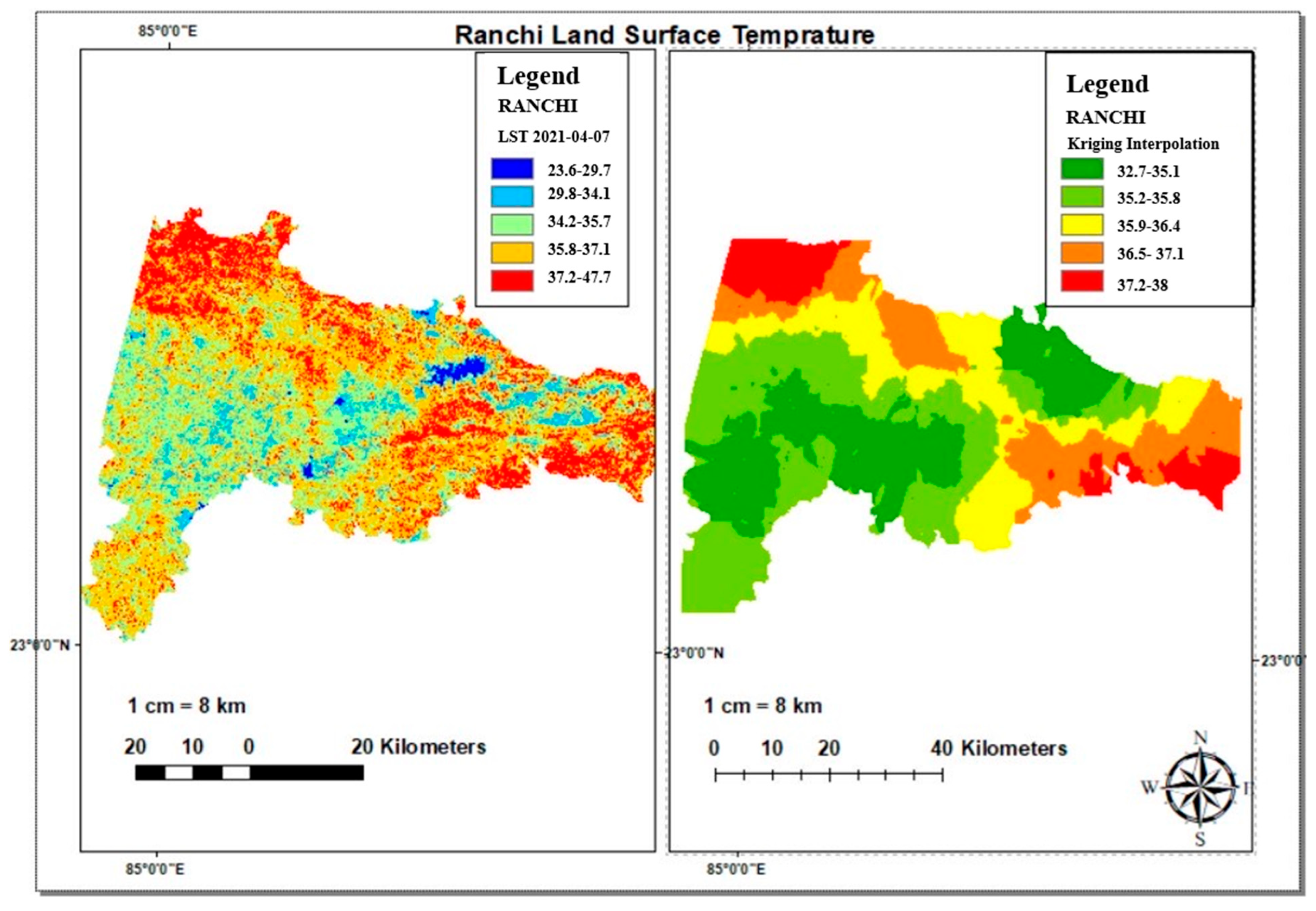

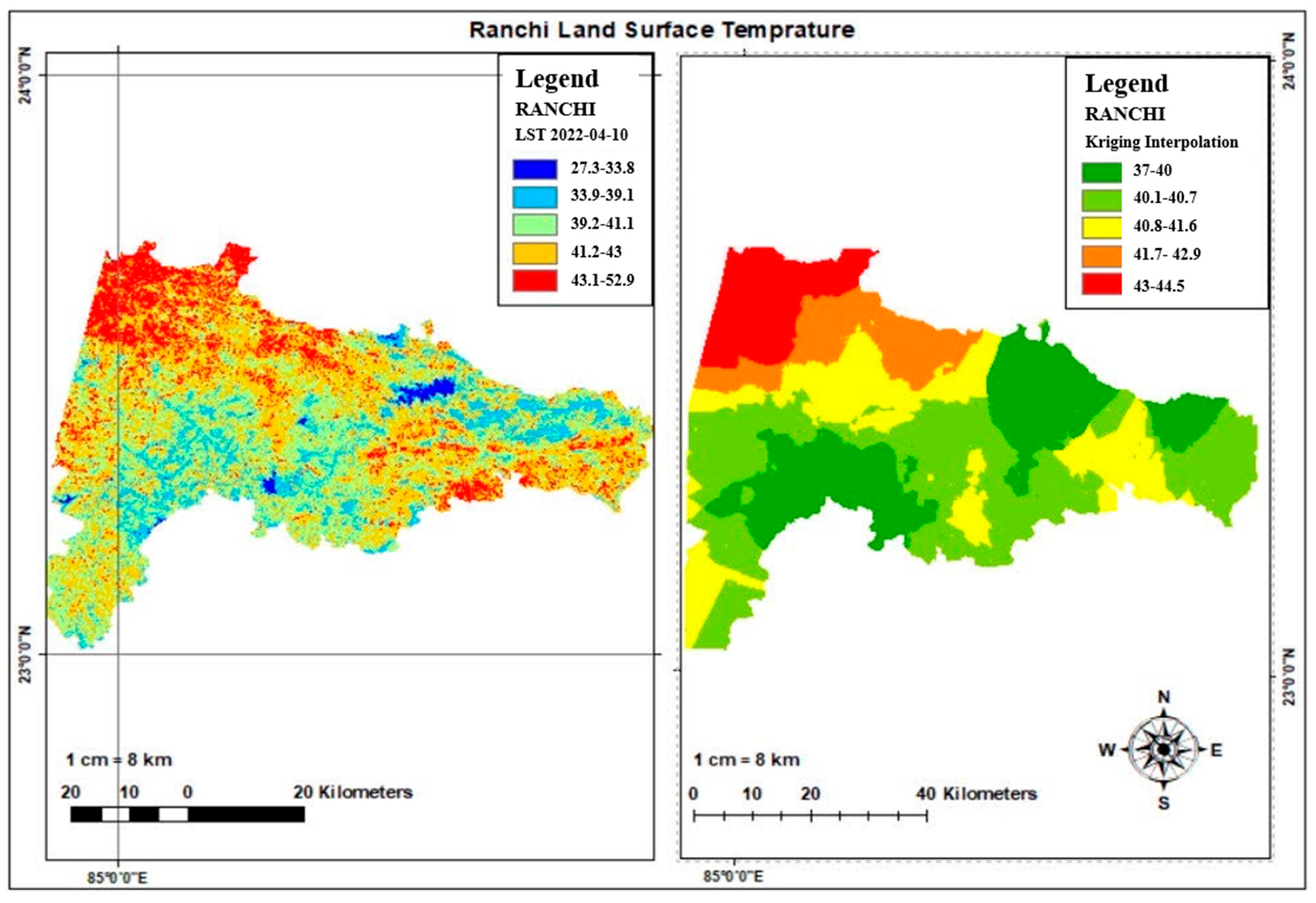


| Parameter | Dhanbad | Ranchi |
|---|---|---|
| Latitude | 23.7957° N | 23.3441° N |
| Longitude | 86.4304° E | 85.3096° E |
| Population | 1,560,384 | 291,425 |
| Area (sq. km) | 2074.68 | 5097 |
| Climate | Humid sub-tropical | Moist sub-humid |
| Elevation (m) | 222 | 651 |
| Average Rainfall (mm) | 1598 | 1355 |
| Band | Wavelength (Micrometers) | Resolution (Meters) | Band | Wavelength (Micrometers) | Resolution (Meters) |
|---|---|---|---|---|---|
| Band 1—Ultra Blue (coastal/aerosol) | 0.435–0.451 | 30 | Band 6—Shortwave Infrared (SWIR) 1 | 1.566–1.651 | 30 |
| Red | 0.452–0.512 | 30 | Band 7—Shortwave Infrared (SWIR) 2 | 2.107–2.294 | 30 |
| Band 3—Green | 0.533–0.590 | 30 | Band 8—Panchromatic | 0.503–0.676 | 15 |
| Band 4—Red | 0.636–0.673 | 30 | Band 9—Cirrus | 1.363–1.384 | 30 |
| Band 5—Near Infrared (NIR) | 0.851–0.879 | 30 | Band 10—Thermal Infrared (TIRS) 1 | 10.60–11.90 | 30 |
| Band 11—Thermal Infrared (TIRS) 2 | 11.50–12.51 | 30 |
| YEAR | District | Radiance Add Band | Radiance Mult Band | K1 Constant Band-10 | K2 Constant Band-10 |
|---|---|---|---|---|---|
| 2019–2022 | Ranchi | 0.10000 | 0.0003342 | 774.8853 | 1321.0789 |
| Dhanbad | 0.10000 | 0.0003342 | 774.8853 | 1321.0789 |
| Lockdown in 2020-1st Wave | Unlock 2020-1st Wave |
|---|---|
| Phase 1 (24 Mr *–14 A *) | Phase 1 (1–30 J *) |
| Phase 2 (15 A *–3 M *) | Phase 2 (1–31 Jy *) |
| Phase 3 (4–17 M *) | Phase 3 (1–31 Au *) |
| Phase 4 (18–31 M *) | Phase 4 (1–30 S *) |
| Phase 5 (1–31 O *) | |
| Phase 6 (1–30 N *) | |
| Lockdown in 2021-2nd Wave | |
| April 5–June 15 |
Disclaimer/Publisher’s Note: The statements, opinions and data contained in all publications are solely those of the individual author(s) and contributor(s) and not of MDPI and/or the editor(s). MDPI and/or the editor(s) disclaim responsibility for any injury to people or property resulting from any ideas, methods, instructions or products referred to in the content. |
© 2023 by the authors. Licensee MDPI, Basel, Switzerland. This article is an open access article distributed under the terms and conditions of the Creative Commons Attribution (CC BY) license (https://creativecommons.org/licenses/by/4.0/).
Share and Cite
Qadri, S.M.T.; Hamdan, A.; Raj, V.; Ehsan, M.; Shamsuddin, N.; Hakimi, M.H.; Mustapha, K.A. Assessment of Land Surface Temperature from the Indian Cities of Ranchi and Dhanbad during COVID-19 Lockdown: Implications on the Urban Climatology. Sustainability 2023, 15, 12961. https://doi.org/10.3390/su151712961
Qadri SMT, Hamdan A, Raj V, Ehsan M, Shamsuddin N, Hakimi MH, Mustapha KA. Assessment of Land Surface Temperature from the Indian Cities of Ranchi and Dhanbad during COVID-19 Lockdown: Implications on the Urban Climatology. Sustainability. 2023; 15(17):12961. https://doi.org/10.3390/su151712961
Chicago/Turabian StyleQadri, S. M. Talha, Ateeb Hamdan, Veena Raj, Muhsan Ehsan, Norazanita Shamsuddin, Mohammed Hail Hakimi, and Khairul Azlan Mustapha. 2023. "Assessment of Land Surface Temperature from the Indian Cities of Ranchi and Dhanbad during COVID-19 Lockdown: Implications on the Urban Climatology" Sustainability 15, no. 17: 12961. https://doi.org/10.3390/su151712961
APA StyleQadri, S. M. T., Hamdan, A., Raj, V., Ehsan, M., Shamsuddin, N., Hakimi, M. H., & Mustapha, K. A. (2023). Assessment of Land Surface Temperature from the Indian Cities of Ranchi and Dhanbad during COVID-19 Lockdown: Implications on the Urban Climatology. Sustainability, 15(17), 12961. https://doi.org/10.3390/su151712961






